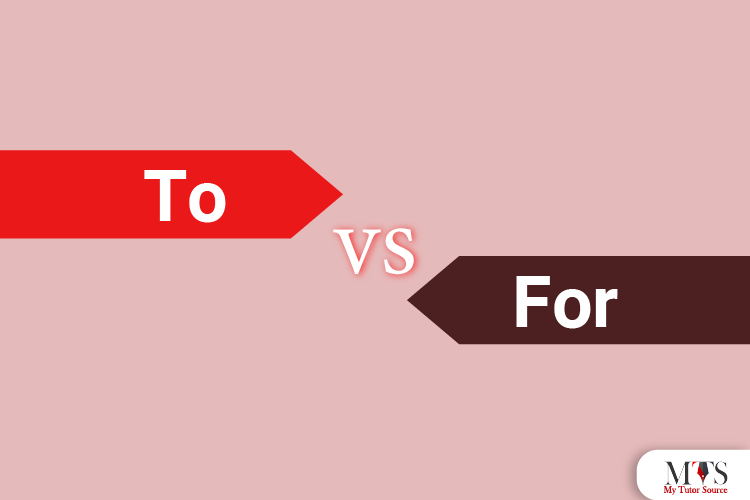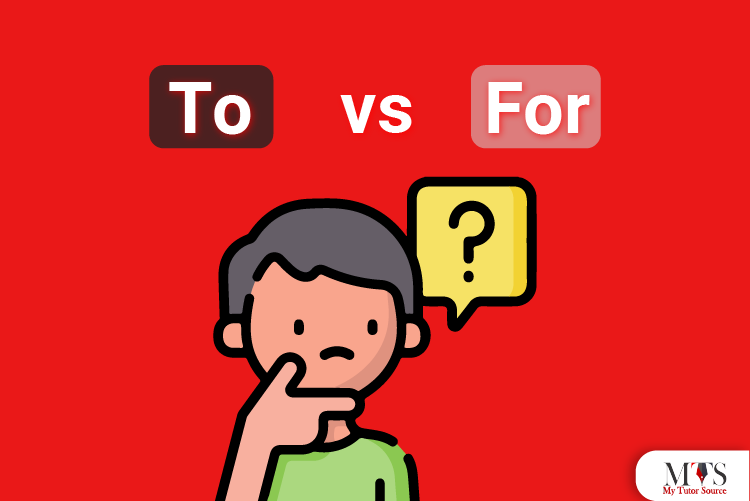

We often use the terms “to” or “for” to describe the reasons or purposes of something in a sentence. They tend to serve the same purpose, but if we look closely, their usage differs. Here we have discussed the basic factors that lead to a difference between the use of these two prepositions.
To talk about why a person has done something or why a particular event happened, we usually add the terms to or for in the sentence that indicates a reason for the matter. It might feel like these terms are used interchangeably, but they have different uses, and there’s a clear difference in the way they are added to the sentence once you know how they differ.
Let’s discuss the basic difference that puts the two terms apart in working.
We use “to” when there is a verb present in a sentence demonstrating reason, whereas when there is a noun present in the sentence, we change the “to” with “for”.
Here are some examples to demonstrate this difference:
By now, we have established how the use of to and for can bring a difference in the sentence that shows a purpose or reason for a particular thing or event.
In the above-mentioned examples, it seems like both prepositions have been used similarly, but looking closely, we get to know how the two can be greatly different from each other in the way they have been used.

Usually, if we are talking about purpose or reason in a sentence, we add “to” when there is a verb present. With verbs, we add “to” instead of using “for” there.
Let’s discuss with an example how “to” is used in the form of proportion.
To is also used for other purposes in a sentence such as:
In English, we use informative verbs as the base form of a verb that has not been affected by any change of form. While using this base form of the verb in a sentence, we add “to” with the verb.
For Instance: I like to paint, or I want to fly high.
In this situation, the use of to indicates that a person or a thing has shown movement or has been transferred from one place to another.
For Instance: I am going to the gym right now, or I took the books to the library.
When using it in this situation, we add “to” before the things we don’t actually prefer after talking about the thing we prefer over it.
For Instance: I prefer mountains to beaches, or He prefers books to movies.
When we are talking about a reason in a sentence, we add for between that event and the reason for it. Instead of “to,” we add “for” when we are talking about the noun as the reason for the event.
Let’s discuss some examples to get a better idea of how “for” works as a preposition.
There are other ways as well that we use “for” in a sentence as demonstrated below:
When we are saying thank you to someone, we usually add the reason along with it as to why we are saying it.
For instance: Thank You for your support, or I must thank you for hosting such a lovely dinner.
When we are talking about a specific time period, instead of just assuming it, we use the word “for” in the sentence.
For instance: I have been going to college for 5 months now, or I stood outside your office for two hours.
When we are showing agreement over something, we add the word for in the sentence.
For Instance: My support is all for the red team, or I am all for the formation of different societies in college.
Since there is a very slight difference between the use of “to” and “for,” you need to make sure that you are using it correctly. This can be made sure by practicing and learning well. The wrong usage of prepositions in a sentence can completely change the meaning of the sentence. Here we have listed ways through which you can practice the use of these prepositions in a correct way in your sentences.

You can find many quizzes online or in books where you will be asked about the correct use of prepositions in a sentence. After guessing or stating your answer, you can check the right answer in the answers given. After checking, you can determine whether the answer you gave was right or wrong. You can keep on practicing with these quizzes on a regular basis. This will help you get a strong grip on your knowledge about using the correct prepositions.
There are several courses that you can join offering grammar improving classes where you practice your grammar or vocabulary skills and the correct use of prepositions. The courses offer learning experiences and creative activities to help you remember the basics leading to the use of a certain preposition so that when you use it, you will use it right.
If you are unable to use the prepositions correctly in your sentences, you can hire a tutor who can guide you individually about how and when to use the right prepositions and other aspects of grammar. A private tutor will help you learn it all from the basics till the point you are sure about your grip over the matter.
To and for are used in a sentence to demonstrate a reason or purpose of a certain event that happened. Even if their use seems the same, there is a particular difference between their usage that makes them two distinct prepositions.
Learn about prepositions and other aspects of grammar with our certified online or private home tutors.